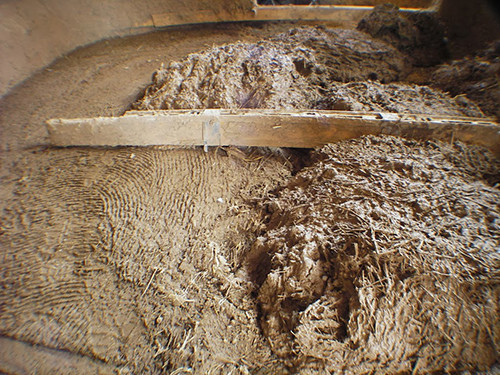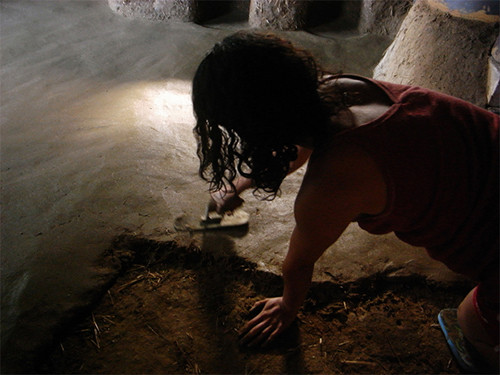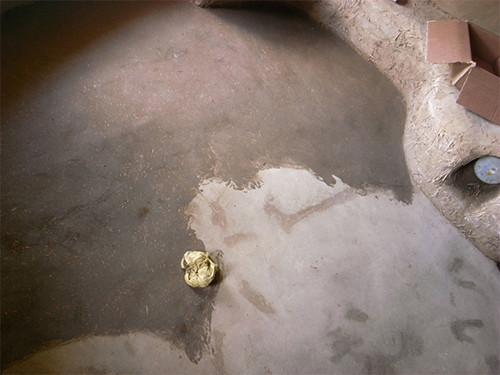The basement can really be made in almost every private house if the type of foundation allows. It can be used in completely different ways-for storing crops and preservations, as a repair workshop or living room. But in order for the additional space to serve as efficiently as possible, it is necessary to carry out high -quality finishes, and it is better to start with the very problematic part - gender. In this article, we will tell in detail how to make the floor in the basement and what materials to use to finish it.
Floor arrangement options
The functionality of the basement can be different, depending on what purposes you built it. But the floor in any case must meet certain requirements. Since it is closest to the ground, the risk that it can be wet and cold is much higher than for rooms on the ground floor. That is why it is important to do everything possible to isolate the floor and make it as stable as possible.
If you want to make a living room out of the basement, then it is better to make the floor out of wood. For the workshop, a concrete screed is perfect, and for storing conservations, products or things you can arrange clay floors. Consider each of these options in more detail.
Concrete floor
The concrete floor in the basement of the house is the most popular solution, since it guarantees high strength, durability and reliability. This is the best option for arranging a basement in areas with a low depth of groundwater. Other materials in such cases are damp and deteriorated, and concrete provides additional waterproofing.
To make concrete floors in the basement of a private house, you will need the following tools and materials:
- the brand cement is not lower than the M400 (if you choose a less durable cement, then the floor will not withstand the load and crack);
- river sand without clay impurities;
- crushed stone for creating drainage through which excess moisture will leave;
- keramzit for floor insulation;
- rolled waterproofing;
- a container for kneading the solution (ideally, it is better to rent a concrete mixer);
- shovel;
- rule;
- construction level.
Below we will briefly describe the process of creating a concrete screed on which you can lay the finish coating. It should also be chosen based on the functional purpose of the basement. For the workshop, it is better to choose ceramic tiles or inexpensive linoleum so that the floor can be easily and quickly washed. For a dwelling, warmer and aesthetic coatings are preferred - carpet, laminate or parquet.
How to fill the floor in the basement of the house:
- Comers and compact the soil surface.
- Make a bulk embankment 15 cm thick, sprinkle it with water and tamp it thoroughly.
- Pour 10 cm of sand onto the gravel, also moisten it with water and compact it. Check evenness by the construction level - you should get an even and dense layer for filling the future sex.
- Put a roll roofing roofing roof on a sand drainage pillow. The waterproofing of the floor in the basement of the house is extremely important. If it is not done, moisture will penetrate concrete and destroy the coating. Instead of roofing material, you can use a thick plastic film in 2 layers. Lay the cuts with an overlap of 10-15 cm and make the walls on the walls by 20 cm.
- In the resulting waterproof “bowl”, pour 15 cm layer of expanded clay - it will protect the floor from freezing. Also, concrete floors can be insulated with mineral wool slabs, polystyrene foam and other solid materials, but expanded clay is cheaper and used most often.
- If you plan to place heavy furniture or appliances in the basement, the floor should be strengthened by a reinforcing mesh with rods with a thickness of 5 mm. For storing vegetables and conservation, reinforcement is optional.
- Now you can start filling the floor in the basement of the house. You need to start from the corner opposite to the exit, gradually moving to the stairs. Pour a little concrete and immediately align it with the rule.

- In the process of creating the screed inside the cement mixture, air voids are necessarily formed. If they are not removed, the floor will come out to be weak, so after you flooded and slightly leveled the segment, treat it with a vibrating plate or check it with a stick.
- Leave the screed to dry for 3 days, periodically spraying with water to prevent it from too fast evaporation. Otherwise, the surface may crack. After three days, you can no longer moisturize the screed, but calmly wait for its complete drying. This usually takes up to 3 weeks.
Leaving a naked concrete floor is not very recommended, because no matter how much it, it will still dust. As an option, you can cover it with a polymer self -leveling mixture or simply paint with enamel (the cheapest option). If you want to make a dwelling out of the basement, you can arrange an insulated wooden floor on the lags on concrete. We will talk about the technology of laying the lag a little later.
Paul in the basement of a private house (video) from concrete:
Clay floor
The technology for the manufacture of clay floors appeared many thousands of years ago, but recently interest in it has resumed. Environmentally friendly, cheap and very comfortable clay floors are increasingly appearing in private houses and even apartments, and for the arrangement of basements they are simply perfect.
Than the clay floors are good:
- Cheapness is a decisive factor for most who started repairs or construction. But for all its efficiency, the clay floor is not inferior in quality to expensive coatings, or even surpasses them. The savings consist not only in the low cost of supplies, but also in the fact that you do not need the help of specialists or large construction equipment.
- Naturalness - the clay floor does not contain hazardous substances, on the contrary, it brings continuous benefits. When walking, clay relieves the load from the feet, and natural components favorably affect the skin.
- Clay can be used again-if you ever want to change the floor in the basement of a wooden house, then from clay and straw you can build a small extension or make a floor in another room.
- Heat-clay perfectly holds heat inside and does not allow the cold from under the ground to penetrate the room. In winter, it heats up quickly, and in the summer it retains pleasant coolness.
- If you properly lay the floor from the Saman (clay with straw), it will never remain spots, scratches or dents. Cleaning will take a couple of minutes!
- The clay floor does not need waterproofing, since the materials themselves as part of the mixture perfectly cope with this function. It is only necessary to organize a drainage pillow and you can start laying the floor.
- Even an ignorant person in construction will cope with the arrangement of the clay floor.
Of course, the technology for making the mixture for the floor underwent some changes and improved, but the essence remained the same. For the manufacture of a samannt coating, you will need clay, river sand, straw, linseed oil, gravel, downpider and bee wax.
The course of work:
- If you live in areas with a wet climate, it is necessary to pour 20 cm layer of gravel on the prepared and compacted land. For the northern regions, the clay floor will need to be additionally insulated. To do this, you can make an embankment 10-15 cm from vermiculite or perlite.

- Put a layer of black floor with a thickness of 5-7 cm on the finished base. Its task is to align the final sex and its insulation. Make a mixture of 30% clay, chopped straw and 70% of sifted sand. In this case, straw provides tensile strength. Greasure a black floor with a vibrating plate or with the help of improvised means.

- The thickness of the final floor will be 2-2.5 cm. The mixture for it is made according to the above recipe, but the straw should be used shorter. Since the quality of clay, sand and straw is everywhere different, it is impossible to accurately guess with proportions and guarantee the same result. Therefore, experts recommend first testing the mixture on a small area. It should turn out to be quite dense, not crumble and not crack when it dries.
- To apply the mixture, use a wide spatula, and for alignment - the rule. The composition should not stick to the spatula, if this happens, then you added too much clay or it is too fat. Dilute the mixture with water and mix thoroughly until smooth. If the solution, on the contrary, does not hold on the spatula, you need to add more clay to it.

- Important: apply the finish layer only after drying the draft floor. This usually takes from 3 to 6 days, depending on the climate.
- In order for the finish coating to be beautiful and even, clay and sand for the solution must be sifted and mixed thoroughly, breaking lumps.
- The composition on the draft floor is applied three times in thin layers, so that in total they give about 2.5 cm. Each subsequent layer is applied after the previous one has completely dried.

- When the third layer is completely dry, you can proceed to the impregnation. To do this, use heated linseed oil, which reliably protects the floor from abrasion and gives a hard and shiny surface. But the impregnation consists of several ingredients. In order for linseed oil to penetrate better into a clay thickness, a turpentine must be added to it. Mineral solvents also allow the same result, but using them against the background of natural and environmentally friendly materials will be a real crime. When working with turpentine, use gloves and provide good basement ventilation.
Oil consumption per 30 square meters. m is 8 liters. The impregnation should be carried out in several visits, each time preparing a new mixture. Apply the second layer only after completely absorbing the previous one and so on. For the first time, the impregnation should consist only of oil, the second layer is a mixture of 80% oil and 20% of the turpentine, the third is 60% of the oil and 40% of the turpentine. Each time add 20% more turpentine to cover it with the floor in its pure form. - The final stage is the flooring of the floor by bee wax. It gives the surface smoothness and makes it pleasant to the touch. Heat the wax and apply it in several thin layers.

Such a flooring in the basement of a private house will allow you to get a strong, even and environmentally friendly surface for many years. But over time, the clay floor, like any other, will have to be updated. To do this, just repeat the impregnation procedure. If chips and small cracks appear during operation, rub them with hard wax and soak them with oil.
Paul on the lags
It is better to make the installation of the floors in the basement of the house on the lags if groundwater runs far from the surface, and the earth is sufficiently dry.
Wooden lags should be treated with antiseptics to protect against decay, insects and rodents. Their length should be less than the length of the room by 2-3 cm, otherwise the floors can be deformed during shrinkage. Choose powerful pine bars with a thickness of at least 150 mm, for black flooring, you can use any raw boards, and for the final it is better to take a downstone with a width of 40-50 mm.
How to make a floor in the basement of the house:
- Since the lags will be installed on soil, it is important to prevent their direct contact with the ground. First of all, compact the base and make a sand pillow 15 cm thick.
- On the pillow, install columns-stands for the lag. Determine which parts of the house will be based on the lags (lower binding, a grillage covered with roofing material, etc.). At the reference points, put the mark with chalk. Then make marks in the places of installation of columns and calculate their number.

- Install pillars of reinforced concrete or brick in the intended places.
- The upper part of the pillars are set aside by waterproofing material.
- Attach to the pillars and supports of the lag using anchor bolts. We remind you that the lags do not need to be set close to the walls-make a distance of 1-1.5 cm on each side.
- By the lower part of the lag, put the support rails and lay on them a black floor. It is not necessary to attach the black floor boards - they must lie freely to exclude deformation in the case of soil of soil or shrinkage of wooden structural elements.
- How to insulate the floors in the basement of the house? The cheapest way is to pour expanded clay on the draft floor or lay mineral wool. If you use cotton wool, it is better to put additional waterproofing under it so that evaporation from the Earth is not damaged by the material. Ustilize the plastic wrap or roofing roofing roofing, holding the cuts with wide tape. Make 20 cm in the walls.

- It is recommended to lay a vapor barrier membrane on top of thermal insulation material.
- Between the boards of the final floor and the insulation, it is necessary to leave the ventilation gap so that the moisture does not accumulate and does not soak thermal insulation. The gap width is about 2 cm. If you use a bilateral vapor barrier membrane, the gap can be reduced to 1 cm.
- Attach the rogue boards of the finish floor across the lag, starting from the far corner of the basement. Return 2 cm from the wall - this gap will subsequently close the baseboard. As an option, you can use non -roped boards, but other material for floor decoration in the basement. If you plan to lay the carpet, put tiles or laminate, close the lags with plywood - it will create a perfectly smooth surface.

You will find more information about the construction of the floor on the lags in the article "Laying wooden lag: master class."
To make the floor in the basement of the house for everyone, since, there are many techniques that are excellent in complexity, cost and practicality. Finally - several useful tips:
Before arranging the floor, think about where the wires and communications will be hidden. The floor on the lags, for example, allows you to lay them without problems and provides access at any time.
If you want to make a wooden coating, choose wood varieties resistant to moisture. The best in this regard are deciduous rocks.
When choosing a carpet as a coating, take into account that if it is wet in the basement, then it will not work to dry the floor normally, and the carpet can mold. In this case, experts recommend dwelling on tiles or self -leveling polymer mixtures.















